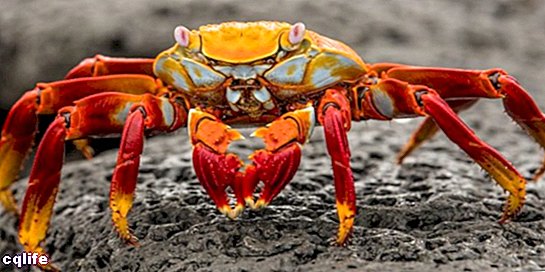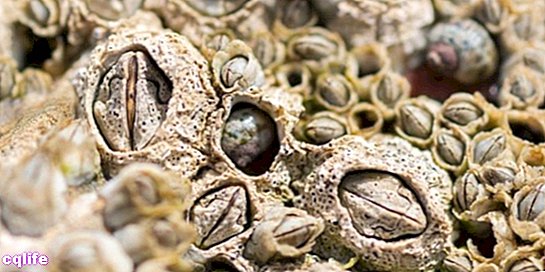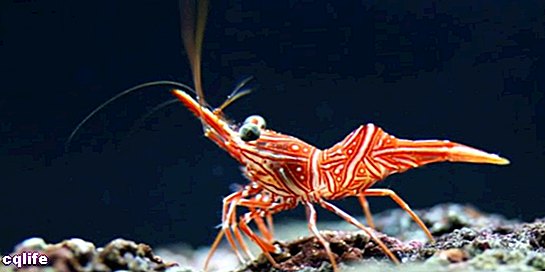- What are crustaceans?
- Characteristics of crustaceans
- Examples of crustaceans
- Types of crustaceans
- Crustacean feeding
- Reproduction of crustaceans
We explain what crustaceans are and how they are classified. In addition, its feeding, reproduction and other characteristics.

What are crustaceans?
Crustaceans (from the Latin crust which means "bark") are arthropods that have an articulated exoskeleton and their size can vary from one millimeter to four meters in length. There are about six thousand seven hundred species living. Like all arthropods, crustaceans are Invertebrate animals.
Most are aquatic species and can live in salt water (like krill), fresh water (like crayfish), or can even live in both types of Water (like shrimp). On a lesser scale, there are terrestrial crustaceans such as the cochineal (also known as the "ball bug").
In general, crustaceans live and move freely. Some are isopod-type parasites that attack fish and other crustaceans, so they depend on their hosts for mobility (such as Artystone trysibia).
There is a minority of crustaceans that do not have limbs and do not move throughout their lives, but remain clinging to the rocks of the sea (like barnacles or sea acorns).
Characteristics of crustaceans
Crustaceans have an exoskeleton that covers a large part of their body and protects them from both predators as from extreme weather conditions. Its physiognomy is divided into two sections:
- Cephalothorax. Covers the head and thorax.
- Abdomen. It is made up of articulated segments.
However, in some species three sections are recognized due to the separation of the head and thorax. They have birameal limbs (that is, legs that branch in two), usually have five pairs of legs and two pairs of antennae.
Crustaceans have a simple digestive system and an excretion system through the “antennal glands” (appendages located under the antennae), which collect waste and expel it through the pores.
Your nervous system is complex: it works by means of ganglia that fuse with each segment of the body. His breathing it is through gills, so they need to live in very humid places.
Examples of crustaceans

Some examples of crustaceans are:
- The remipedios. They are the most primitive and inhabit the depths of the sea, in areas such as Australia, the Caribbean Sea, the Indian Ocean and the Canary Islands. They are characterized by being blind, by swimming on their backs and by being hermaphrodites.
- The crabs. They are of the banchiopoda type and inhabit the coasts of most of the world. His feeding It is omnivorous and its size varies greatly depending on its species (from a few millimeters to more than a meter wide). During the growth stage, if they lose a limb, they can regenerate it.
- The barnacles. They are those who live on rocks by the sea. They are characterized by having no limbs and by remaining attached to stones throughout their lives. They feed on plankton and detritus (solid remains in the form of particles, which come from the organic material) that they consume through filtration thanks to the food that the waves bring.
- The artystone trysibia. They are parasitic crustaceans of the isopod type that during their youth swim through fresh waters and in adulthood they stay in the mouth of the fish until they manage to reach and occupy the abdominal cavity.
- Mealybugs. Also known as “bicho pelita”, they are crustaceans that, despite having adapted to the terrestrial habitatThey breathe through gills (therefore, they need to live in humid places). They usually walk at night and have a life expectancy of three years.
- Kriles. They are very curious crustaceans that have luminous organs called "photophores" (near the mouth and genitalia) that emit light the color blue. There are several theories regarding the function of this light, but the most consistent is that they fulfill reproductive functions.
- Copepods. They are parasitic crustaceans of the maxillopod type and of very small size (they reach ten millimeters in length). They do not have a shell, but they do have a brain shield and only one eye. Their diet is based on plankton.
Types of crustaceans
Crustaceans are classified into six types:
- Banchiopoda. They are those that live in fresh water. They are characterized by being small and by having external gills at the back of the head. They may have a shell-shaped shell (such as clam shrimp, of the order laevicaudata), of a brain shield (such as notostraceans), or no shell (such as brine shrimp, of the order Anostraceans).
- Remipedia. They are those that do not have eyes, usually have an elongated body (similar to that of the worm) and have a first pair of antennas that they use as a smell sensor (to detect dead animals). They live in caves in the depths of the sea, in areas such as Australia, the Caribbean Sea, the Canary Islands and the Indian Ocean.
- Cephalocarida. They are one of the most primitive. They live in the mud and sand of the soils deepest of the sea. They are very small (between two and four millimeters), do not have eyes and are hermaphroditic. They feed on debris.
- Maxillopoda. Its name comes from the Greek maxilla which means "jaw" and pous which means "foot". Its body is very small and the jaw and lower limbs are very close. They have a nervous system very primitive and simple. They feed on bacteria of suspended organic matter and the blood of others individuals (in the case of parasite-type species).
- Ostracoda. They are those that live in salty and sweet waters. They have a shell similar in appearance to oysters, of the bivalve type (divided into two shells). The sensitivity of their eyes varies in each species and they can be photo-receptors, thermo-receptors and mechano-receptors.
- Malacostraca. They are crustaceans that inhabit fresh and salty waters, with some exceptions of terrestrial species (that live on tropical coasts). They have a semi-soft shell and sensory hairs that line their legs. Are carnivores Y predators, which feed on small mollusks and fish.
Crustacean feeding

The diet of crustaceans varies according to the different species. The simplest type of feeding is filter feeding (such as copepods and small shrimp). Others are scavengers and they feed on the remains of creatures, or are active predators, such as crabs and lobsters that go out at night to hunt.
Your digestive system is straightforward. It is usually made up of a straight duct and, through an organ that functions as a food grinder, they carry out digestion. In other cases, they often have spiral-shaped digestive glands that absorb nutrients.
Reproduction of crustaceans
Crustaceans have a reproductive system of a sexual type and oviparous (that is, by external fertilization of the egg). Some species have a direct development (an individual is born already formed from the egg). However, most crustaceans have an indirect development (they are born as larvae and evolve in their maturity stage).
Most crustaceans have separate sexes, although there are a few species that are hermaphrodites (that is, the same individual has both sexes: female and male), such as barnacles. Other species change their sex as they mature.
